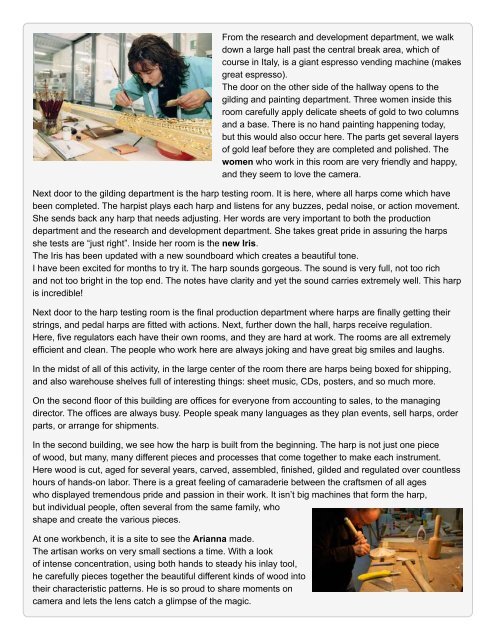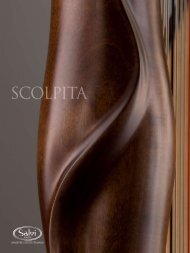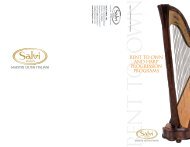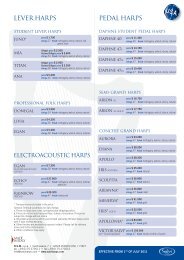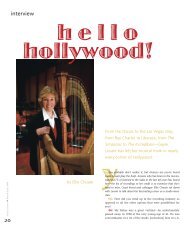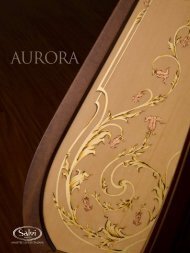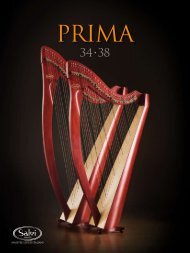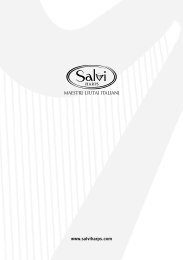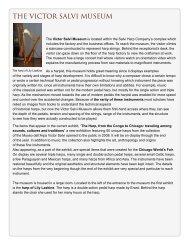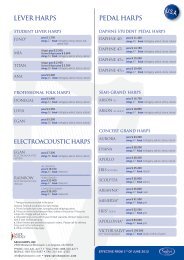You also want an ePaper? Increase the reach of your titles
YUMPU automatically turns print PDFs into web optimized ePapers that Google loves.
From the research and development department, we walk<br />
down a large hall past the central break area, which of<br />
course in Italy, is a giant espresso vending machine (makes<br />
great espresso).<br />
The door on the other side of the hallway opens to the<br />
gilding and painting department. Three women inside this<br />
room carefully apply delicate sheets of gold to two columns<br />
and a base. There is no hand painting happening today,<br />
but this would also occur here. The parts get several layers<br />
of gold leaf before they are completed and polished. The<br />
women who work in this room are very friendly and happy,<br />
and they seem to love the camera.<br />
Next door to the gilding department is the harp testing room. It is here, where all harps come which have<br />
been completed. The harpist plays each harp and listens for any buzzes, pedal noise, or action movement.<br />
She sends back any harp that needs adjusting. Her words are very important to both the production<br />
department and the research and development department. She takes great pride in assuring the harps<br />
she tests are “just right”. Inside her room is the new Iris.<br />
The Iris has been updated with a new soundboard which creates a beautiful tone.<br />
I have been excited for months to try it. The harp sounds gorgeous. The sound is very full, not too rich<br />
and not too bright in the top end. The notes have clarity and yet the sound carries extremely well. This harp<br />
is incredible!<br />
Next door to the harp testing room is the final production department where harps are finally getting their<br />
strings, and pedal harps are fitted with actions. Next, further down the hall, harps receive regulation.<br />
Here, five regulators each have their own rooms, and they are hard at work. The rooms are all extremely<br />
efficient and clean. The people who work here are always joking and have great big smiles and laughs.<br />
In the midst of all of this activity, in the large center of the room there are harps being boxed for shipping,<br />
and also warehouse shelves full of interesting things: sheet music, CDs, posters, and so much more.<br />
On the second floor of this building are offices for everyone from accounting to sales, to the managing<br />
director. The offices are always busy. People speak many languages as they plan events, sell harps, order<br />
parts, or arrange for shipments.<br />
In the second building, we see how the harp is built from the beginning. The harp is not just one piece<br />
of wood, but many, many different pieces and processes that come together to make each instrument.<br />
Here wood is cut, aged for several years, carved, assembled, finished, gilded and regulated over countless<br />
hours of hands-on labor. There is a great feeling of camaraderie between the craftsmen of all ages<br />
who displayed tremendous pride and passion in their work. It isn’t big machines that form the harp,<br />
but individual people, often several from the same family, who<br />
shape and create the various pieces.<br />
At one workbench, it is a site to see the Arianna made.<br />
The artisan works on very small sections a time. With a look<br />
of intense concentration, using both hands to steady his inlay tool,<br />
he carefully pieces together the beautiful different kinds of wood into<br />
their characteristic patterns. He is so proud to share moments on<br />
camera and lets the lens catch a glimpse of the magic.


